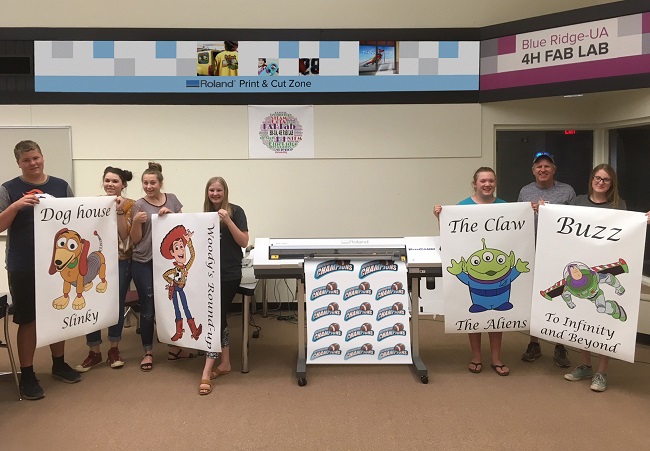One way to get more students interested in studying science, technology, engineering, and math (STEM) topics is to give them access to software and tools they can use to design, create, or customize their own products. That’s the concept behind Fab Labs, which are being opened in libraries and community centers nationwide.
For example, the Blue Ridge/University of Arizona 4-H Fab Lab is an “open source, open door” digital fabrication facility. It gives students in grades K-12 and community members access to the digital design tools, electrical platforms, 3D printers, wide-format printer/cutters, laser engravers, and training they need to make their own graphics, stickers, 3D objects, and product prototypes.
State-of-the-art equipment for 3D printing, laser engraving, milling, graphics printing, contour cutting, and product customization was donated by companies such as Ultimaker, Epilog, and Roland DGA.
The Roland equipment includes a VersaUV LEF-12 UV flatbed printer, VersaCAMM SP-300i wide-format printer/cutter, CAMM-1 GS-24 desktop cutter, and MDX-40A milling machine.
Recently, the Fab Lab hosted students from the White Mountain Apache Tribe as well as leaders from 4-H chapters in Pima, Coconino, Apache, Maricopa, and Navajo counties.
“By giving young people the opportunity to make everything from digitally printed banners to 3D milled prototypes, we’re helping to create the next generation of STEM professionals,” said Kevin Woolridge, co-director of the Blue Ridge/UA 4-H FAB LAB. The simple operation and impressive capabilities of the devices in our lab make it possible to interest and engage users of all ages.”

The visiting students from the White Mountain Apache Tribe STEM Program used the Roland printer and software to create banners that the Canyon Day Robotics team used at the IVEX IQ Junior High World Championships in Kentucky. The students made supplies they needed for three different STEM projects on the lab’s 3D devices.
“The students used our Roland VersaUV LEF-12 UV flatbed printer to produce VEX Robots name tags that incorporated their very own graphic designs,” noted Co-Director Steve Gouker, who represented the University of Arizona’s 4-H program in the Fab Lab. “Seeing the light in the kids’ eyes when they got to hold their finished projects was amazing. It was like they were opening presents on Christmas Day.”
According to Bruce Goode, Director of the White Mountain Apache Tribe STEM Program, the students enjoyed their first visit to the Blue Ridge/UA 4-H FAB LAB tremendously. “It was a valuable learning experience for everyone involved,” said Goode. “We intend to continue exposing our Native American students to STEM projects and new technologies by bringing additional groups to the lab.”
Leaders of the Pima County 4-H Chapter in Tucson visited the Fab Lab to explore how to use the lab to provide members with access to 21st century learning opportunities. While the chapter’s 800 members focus primarily on agriculture-based learning projects, the organization is seeking to bridge traditional 4-H projects with modern STEM education.

Vincent McGurk, a 4-H alumnus, Pima County 4-H Americorps member, and one of the individuals that toured the facility, used the lab’s Roland wide-format inkjet to print out several new banners. A 4-H member who aspires to become a graphic designer, designed the banners. “This was the best day at work ever!” said McGurk. “I can see how we can get kids excited about using this kind of cutting-edge technology.”
By utilizing open-source technologies, the Pima County 4-H Chapter plans to create new projects for young people interested in the STEM field, and will use the lab’s real-world production capabilities.
“Awareness of our lab and the great learning opportunities we offer is growing rapidly,” said Woolridge. “There’s already significant interest in establishing a “mini” Fab Lab in Tucson to complement our main Blue Ridge/UA 4-H facility in Pinetop-Lakeside.”
The Fab Lab concept was started by MIT’s Fab Foundation. A Fab Lab is a place where students, parents and community members can interact, learn and create in an atmosphere of 21st century learning, skills and tools.

